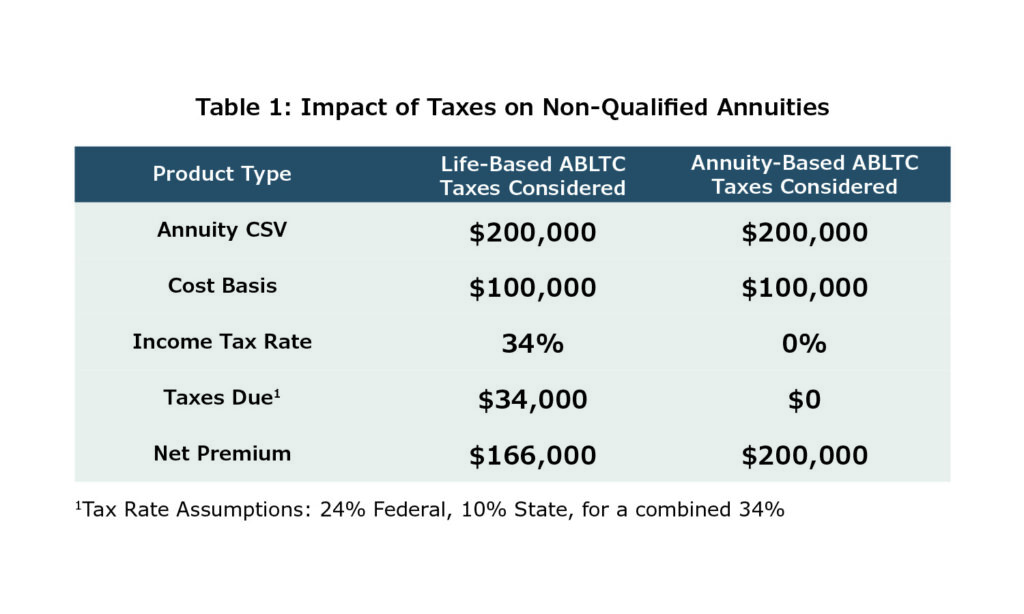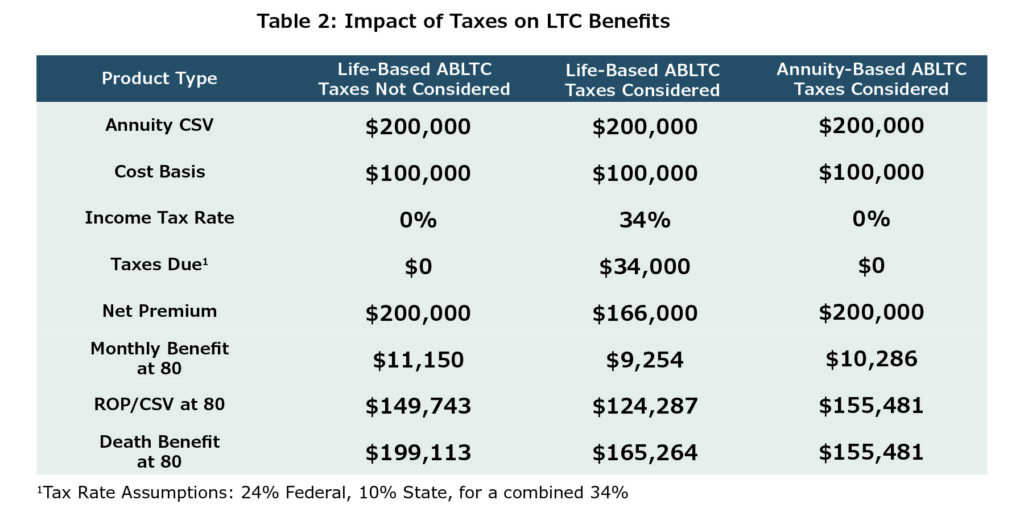Welcome
DIY BRANDABLE CAMPAIGNS
Everything you need to create your own marketing campaigns using our brandable templates and campaign assets. To get started, click the asset you would like to use below. Highlight and right-click the text, select Copy, and then paste the text into your website, email, or social media sites.
CAMPAIGN ASSETS
It can be tempting to use an “apples-to-apples” approach when considering the premium deposit used to fund an Asset-Based LTC solution. Given the availability of a tax-free 1035 exchange when an annuity is the source of funds, it’s critical to take any taxes due on the surrender of the annuity into account when determining the amount available to fund the strategy.
We all know how important it is to keep things simple for clients. Covering the essential components of a planning strategy as efficiently as possible increases understanding and improves the quality of their decisions.
In the Asset-based Long-Term Care (ABLTC) segment, however, a detail that is often overlooked is the source of funds. Specifically, clients need to understand the pros and cons of using non-qualified funds versus qualified funds and annuities versus brokerage accounts when funding their care planning strategy.
This becomes even more important when we consider the tax ramifications specific to each funding source, particularly when considering non-qualified annuities. Why call out non-qualified annuities specifically? Simple: there’s an opportunity to avoid a taxable event altogether by selling an annuity-based ABLTC product. The availability of a tax-free 1035 exchange into an annuity-based ABLTC product unlocks the power of the Pension Protection Act and changes the true cost of the care planning strategy.
These cases can play out in a couple of different ways. The most common is a “Money Purchase” approach that starts with the existing annuity’s cash value. That amount is used as the single premium to purchase an ABLTC solution. The tax issue is often overlooked and has a material impact on the decision-making process. More specifically, the single premium used to fund a life-based ABLTC product should be discounted by taxes due to the liquidation of the annuity. That net amount is then used as the single premium on a life-based solution, while the full amount can fund an annuity-based product. Please see Table 1 for an example.
Table 1: Impact of Taxes on Non-Qualified Annuities

Table 1 shows the significant difference in the net premium available to fund a care planning strategy with funds from a non-qualified annuity based on the type of ABLTC product being considered. At the same time, the full amount is available for an annuity-based product. The lower net amount of taxes is what is truly available to fund a life-based care planning strategy.
The resulting impact of an increased premium on available LTC benefits is evident: With more funds deposited into the annuity product, the corresponding benefits may be richer. This does not mean an annuity-based product will consistently outperform a life-based product. However, it will increase the frequency of the annuity-based solution delivering superior benefits.
The fundamental question that needs to be answered is whether the increased funding into the annuity-based solution is offset by the superior leverage typically in life-based products. In this case, with a 35% combined tax rate assumption, the life-based product would have to deliver a 20.48% greater monthly benefit per dollar of premium for the total monthly benefit to equal the benefits available from an annuity-based solution. The following calculation demonstrates this:
- Life-Based Premium: $166,000
- Annuity-Based Premium: $200,000
- Shortfall: $34,000
- Shortfall as % of Life-Based Premium: $34,000/$166,000 = 20.48%
Consider a sample case with the following case design parameters:
Male, age 70
- Couples Discount
- 6-year Benefit Period
- 3% COLA
- Maximum Monthly Benefit
Revisiting the cash flows from Table 1 above, including the corresponding monthly benefit amounts, shows the superior outcome of the annuity-based solution for this case and how it could have been “hidden” if the reduced after-tax deposit amount was not used. Please see Table 2 for additional details:
Table 2: Impact of Taxes on LTC Benefits

Table 2 shows how the source of funds impacts case design. Not taking the taxes due on the surrender of the annuity into account could easily lead to a sub-optimal recommendation. At first glance, it appears that the life-base solution is superior. However, that design has a hidden cost of more than $34,000 in taxes, as seen in the column titled Life-Based ABLTC, Taxes Considered.
This effectively reduces the amount available to fund the life-based strategy. A review of the additional two columns showing the impact of taxation points to the annuity as the superior solution in terms of monthly benefit. In this case, the monthly benefit at age 80 is $1,032 or 11.15% higher in an annuity-based solution.
Other Considerations
While the primary metric in a care planning case is the monthly benefit amount, other factors are at play. The death benefit that may pass to beneficiaries if not accelerated for care is likely the most significant. Not only are death benefits from life-based products typically larger, but they are also tax-free to the beneficiaries. Liquidity is typically superior in an annuity-based versus life-based product. These factors will need to be considered as part of the decision-making process.
Another important point to consider is the use of a COLA Rider. Annuity-based products like the one used in this example may perform better without a COLA Rider. If used to project future benefits, the current crediting rate of the annuity can result in a greater monthly benefit. That amount, of course, is not guaranteed, while the benefits available from the COLA Rider are contractually guaranteed. Given the nature of the sale, the guaranteed benefits are likely more appropriate and directly comparable to those from a life-based solution.
All of the above and the ultimate outcome depend not only on the appropriate premium amounts but also on the client’s age, the use of a COLA Rider, and the like. None of that, however, changes the bottom line. We must use the annuity value net of applicable taxes when running proposals.
A potential complication is an annuity with a surrender value over the premium needed to fund the strategy. Fortunately, most annuity carriers, including those that offer annuity-based ABLTC products, also provide other annuity products and may be able to execute a “split 1035 exchange” upon receipt of the funds. This would allow a portion of the exchanged funds to be allocated to the annuity-based ABLTC product, with the balance deposited into a different annuity product from the same carrier. While more complicated, the surrendering company may be able to facilitate a split exchange involving two different receiving companies, creating additional flexibility for clients in this situation.
Underwriting also plays a role. Annuity-based ABLTC products may offer a simplified underwriting process that accommodates certain health conditions.
Next Steps
Fortunately, taking the impact of taxes into account in these scenarios involves only two additional pieces of data and a bit of math: when working with non-qualified annuities, always calculate the net premium amount using the cost basis and an income tax rate assumption when not utilizing a 1035 Exchange. Use the resulting net proceeds to fund a life-based product and run proposals for both life-based and annuity-based products accordingly. The results may surprise you!
Using an “apples to apples” approach is tempting when considering the premium deposit used to fund an Asset-Based LTC solution. Given the availability of a tax-free 1035 exchange when an annuity is the source of funds, it’s critical to take any taxes due on the surrender of the annuity into account when determining the amount available to fund the strategy. Fortunately, taking the impact of taxes into account in these scenarios involves only two additional pieces of data and a bit of math.
Interested in learning more? Let’s chat!
#AssetBasedLTC #Annuities #1035Exchange
Subject Line: Maximizing the Value of Your Asset-Based LTC Plan
It is tempting to take an “apples-to-apples” approach when considering the premium deposit used to fund an Asset-Based LTC solution.
In the Asset-Based Long-Term Care (ABLTC) segment, a detail that is often overlooked is the source of funds. Specifically, clients need to understand the pros and cons of using non-qualified funds versus qualified funds and annuities versus brokerage accounts when funding their care planning strategy.
Given the availability of a tax-free 1035 exchange when an annuity is the source of funds, it’s critical to take any taxes due on the surrender of the annuity into account when determining the amount available to fund non-annuity strategies.
If you want to take a closer look at how we’re designing this strategy with other advisors, contact me for more information.



